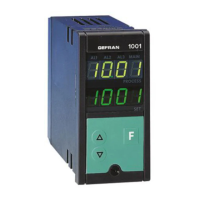7 • PROGRAMMING
Standard protection level 19. Phase CFG2 parameters are
not subject to software protection (access to phase CFG2
depends only on state of jumper S9 (HW config.).
_AI/: Alarm output function.
Configuration of symmetrical deviation alarms requires setting
of positive setpoints only. For correct function, negative values
are not allowed (even if settable).
0 = Alarms 1 and 2 direct absolute (relay energized when
alarm limit is exceeded).
1 = Alarm 1 deviation, Alarm 2 absolute, both direct.
2 = Alarm 1 absolute, Alarm 2 deviation, both direct.
3 = Alarm 1, Alarm 2 direct deviation.
4 = Alarm 1 reverse absolute
(relay energized below alarm limit),
Alarm 2 direct absolute.
5 = Alarm 1 reverse deviation, Alarm 2 direct absolute.
6 = Alarm 1 reverse absolute, Alarm 2 direct deviation.
7 = Alarm 1 reverse deviation, Alarm 2 direct deviation.
8 = Alarm 1 direct absolute, Alarm 2 reverse absolute.
9 = Alarm 1 direct deviation, Alarm 2 reverse absolute
10 = Alarm 1 direct absolute, Alarm 2 reverse deviation.
11 = Alarm 1 direct deviation, Alarm 2 reverse deviation.
12 = Alarm 1, Alarm 2 reverse absolute.
13 = Alarm 1 reverse deviation, Alarm 2 reverse absolute.
14 = Alarm 1 reverse absolute, Alarm 2 reverse deviation.
15 = Alarm 1, Alarm 2 reverse deviation.
By adding 16 to the selected function code (ex. 9+16 setting
25), AL1 becomes symmetrical deviation: in this case, a direct
alarm corresponds to an alarm with relay energized outside the
“window”, while a reverse alarm corresponds to an alarm with
relay energized inside.
By adding 32, AL2 becomes symmetrical deviation.
By adding 48, both alarms become symmetrical deviation.
Out/: Main output function (Heat/Cool) and AL1 (PD) enable
HB alarm and selection of temperature scale (°C or °F)
Set code for selected combination of functions as per the table.
Nr. Al.HB AL1 OUT Scale
0 Disabled NO PD HEAT °C
1 Enabled NO PD HEAT °C
2 Disabled PD HEAT °C
3 Enabled PD HEAT °C
4 Disabled NO PD COOL °C
5 Enabled NO PD COOL °C
6 Disabled PD COOL °C
7 Enabled PD COOL °C
8 Disabled NO PD HEAT °F
9 Enabled NO PD HEAT °F
10 Disabled PD HEAT °F
11 Enabled PD HEAT °F
12 Disabled NO PD COOL °F
13 Enabled NO PD COOL °F
14 Disabled PD COOL °F
15 Enabled PD COOL °F
By adding the following 6 STEPS to the 16 combinations, you
can get various combinations for AL3.
+0 AL3 NORMAL DIRECT ABSOLUTE
+16 AL3 DEVIATION DIRECT NORMAL
+32 AL3 ABSOLUTE REVERSE NORMAL
+48 AL3 DEVIATION REVERSE NORMAL
+80 AL3 DEVIATION DIRECT WINDOW
+112 AL3 DEVIATION REVERSE WINDOW*
When limit AL3 = 0 or is negative, AL3 remains energized or
de-energized at all times.
Note:The PD alarm cannot be symmetrical.
TyP/ Type of input probe or linear scale.
Code 1000 1001/1101
0 J 0...800°C/32...999°F J 0...800°C/32...1472°F
1 K 0...999°C/32...999°F K 0...1300°C/32...1999°F
2 N 0...999°C/32...999°F N 0...1300°C/32...1999°F
3 S 0...999°C/32...999°F S 0...1600°C/32...1999°F
4 R 0...999°C/32...999°F R 0...1600°C/32...1999°F
5 T -100...400°C T -100...400°C
-148...752°F -148...752°F
6 PT100 -199...400°C PT100 -200...400°C
-199...752°F -328...752°F
7 PT100 -19,9...99,9°C PT100 -199,9..199,9°C
-19,9...99,9°F -199,9..199,9°F
8 0-50mV no decimals (xxx) 0-50mV no decimals (xxxx)
-999...1999
9 0-50mV 1 decimals (xx.x) 0-50mV 1 decimals (xxx.x)
10 0-50mV 2 decimali (x.xx) 0-50mV 2 decimals (xx.xx)
11 PT100 -19,9...99,9°C PT100 -19,9...199,9°C
-3,8...99,9°F -3,8...199,9°F
12 10-50mV no decimals (xxx) 10-50mV no decimals (xxxx)
13 10-50mV 1 decimals (xx.x) 10-50mV 1 decimals (xxx.x)
14 10-50mV 2 decimals (x.xx) 10-50mV 2 decimals (xx.xx)
For TC probes type S and R, precision is in the instrument
class (0.5%) for temperatures > 200°C
Ct.A / AL1 Cycle time in range 0...200 sec.
dt.A / AL1 Derivative time in range 0.00...9.99 min. (1000)
0.00...19.99 min (1001-1101).
oFt / Input offset adjustment
for 1001/1101:
-300/300 for type 0,1,2,3,4,5,6,8
-30.0/30.0 for type 7,9
-3.00/3.00 for type 10
for 1000:
-199/300 for type 0,1,2,3,4,5,6,8
-19.9/30.0 for type 7,9,
-1.99/3.00 for type 10
LO.S / Minimum value of setpoint and absolute alarms in scale
range of selected probe. Start of linear scale for probe type 8,
9, 10, 12, 13, 14
Hl.S / Maximum value of setpoint and absolute alarms in scale
range of selected probe. End of linear scale for probe type
8,9,10, 12, 13, 14.
rEL/ Setting of alarm output state in case of broken probe
(message Sbr/Err on display), according to table:
rEL Output AL1 Output AL2 Output AL3
0 ON ON ON
1 ON ON OFF
2 OFF ON ON
3 OFF ON OFF
4 ON OFF ON
5 ON OFF OFF
6 OFF OFF ON
7 OFF OFF OFF
Note: In case of broken probe, each relay assumes the set
state (ON = energized, OFF = de-energized), which does not
depend on the type of alarm (direct or reverse).
7
80343I_MHW_1000_07-2011_ENG
7 / 19

